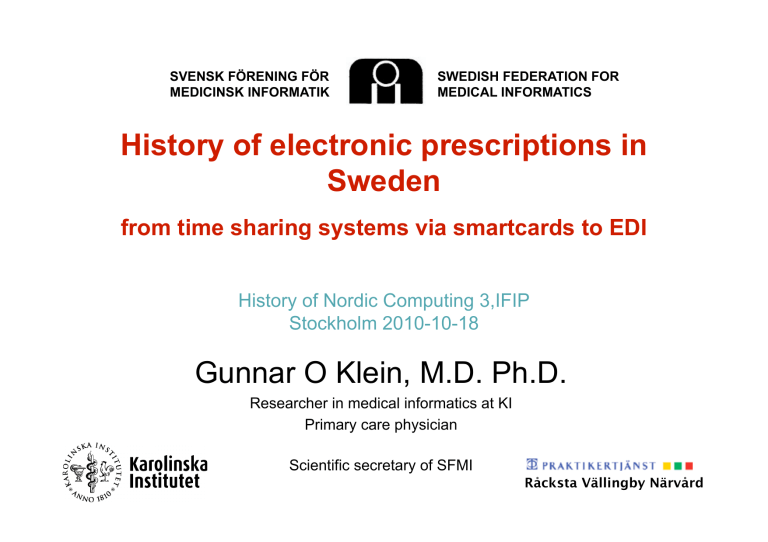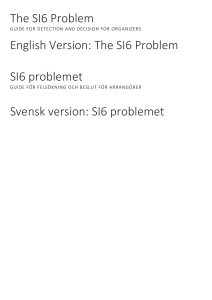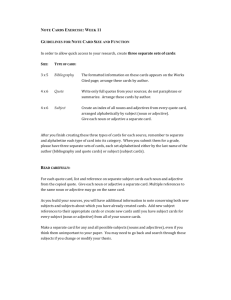History of electronic prescriptions in Sweden Gunnar O Klein, M.D.

SVENSK FÖRENING FÖR
MEDICINSK INFORMATIK
SWEDISH FEDERATION FOR
MEDICAL INFORMATICS
History of electronic prescriptions in
Sweden from time sharing systems via smartcards to EDI
History of Nordic Computing 3,IFIP
Stockholm 2010-10-18
Gunnar O Klein, M.D. Ph.D.
Researcher in medical informatics at KI
Primary care physician
Scientific secretary of SFMI
Råcksta Vällingby Närvård
Personal Journey
• Developer of a test system for the
Pharmacy printers at Philips Bank
Terminal Systems AB in Vällingby 1972-73
• Director, Infocard company 1987-92
• EU project leader for secure communication and standardisation at
Spri - Swedish Institute for Health Services Development and Karolinska Institutet 1993-2005
• Medical informatics academic and a prescribing general practioner
Issues addressed by ICT for medication
• Decision support to the prescribing physicians to improve quality of medication selections to optimize the chance of efficacy and minimize the risk of adverse reactions.
• Improving cost-efficiency for the pharmacies moving from hard to read paper scripts to computerized support for retail, billing and safety checks.
• Improved services to the customers/patients
Apoteksbolaget
• Apotekens Terminalsystem ATS
• Minicomputer DG and terminals at the
Pharmacy office
• Pricing, Sales statistics and printing of labels with dosage information
• Already 1970ies almost all pharmacies where computerised
The Bankeryd Trial
• Prescribing doctors in the same building as the pharmacy were conected to the local Pharmacy terminal system and could make prescriptions. Access to database of products but no decision support
The communication and security problems
• No networks to the doctor’s office
• Slow telephone modems 9600 baud
• Authentication and confidentiality issues
The Infocard System
• 1986-88
• Microprocessor (Smart Cards) with
EEPROM
• The card as a bearer of medication history
• The card as a bearer of prescriptions
• The Tjörn trial
Decision support
EDI
• 1990ies when electronic health record systems at the desktop of the outpatient clinics went from
5 to 90% prescription functionality was added to the record systems. From Printer to EDI.
• Denmark was a pioneering country for this and on a European scale an EDIFACT message was developed to represent an electronic prescription.
• This was adapted to Sweden and used until about 2001.
Patient inclusion
• The card trial included the patient as a controller of the data and a legitimate user
• It was not until recently that the citizens have access to their prescriptions on-line
References
1. Klein GO. Infocard in Pharmacy. Proceedings of the North American Conference on
Patient Cards, New Orleans March 1992. pp 1-3. (1992)
2. Klein GO. Aktiva kort - En nyckel till säkrare IT och effektivare vård. Fakta och visioner om personal- och patientkort. Spri rapport. 90 sidor (1997).
3. Klein GO, ISO/TR 22790 Health informatics – Functional characteristics of prescriber support systems (2007)
4. Klein GO. Final report of the project Trustworthy Health Telematics 1 (Trusthealth).
Deliverable D1.4. 16 pages. (1998)
5. Klein, G.O.: Security principles for patient card systems in the Proceedings of the
Fourth Global Congress on Patient Cards and Computerization of Health Records
(Köhler, C.O. and Waegeman eds), Newton, Mass, USA: Medical Records Institute,
77-87. (1992)
6. Klein GO. Smart Cards - a tool for carrying medical information by patients and creating digital signatures by professionals. Conference of the International Federation of
Information processing/TC 11 Security. Cape Town. Annex "Information Security on the
Electronic highways of Sweden" In Information Security – The next decade,
Chapman&Hall, 1-20 (1995)
7. Klein GO. The Swedish Prescription Card Trial - A technical report. Published by
Apoteksbolaget in the co-operation between Sweden and the French Ministry of Health.
29 pages. (1992)


